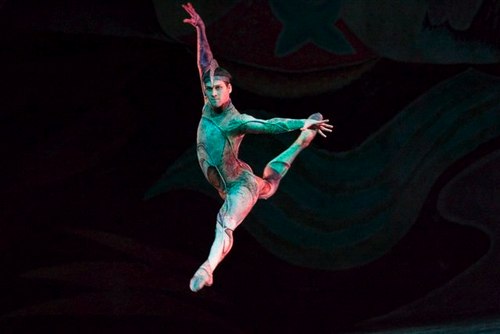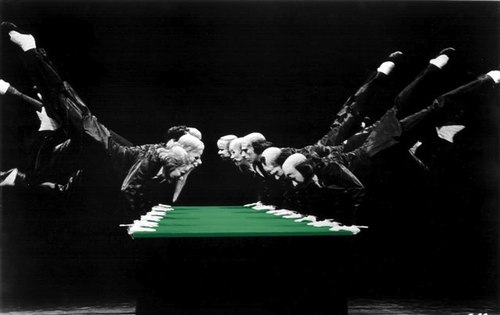|
 |
|
|
 |
 |
Before a slipper was tied or a baton raised, Dr. Leslie Dunner, Music Director and Principal Conductor for the Joffrey, spoke at a pre-performance Diversity Council reception on "Notes from the Pit." An entertaining and eloquent speaker, Dr. Dunner expressed his musician's relationship with dancers as being "symbiotic, a pas de deux." Because the dancer and conductor must work together though physically separated, he termed the collaboration "a partnership with motion in space." In fact, Dr. Dunner revealed he had actually taken ballet lessons both to improve his center of balance and to understand the dancers. Chatting with Dr. Dunner, he honored me and my guest with an invitation to sit in the Orchestra pit for the first ballet of the evening, an opportunity not to be missed. Thank goodness we were wearing the obligatory orchestra black! Les Présages: (World Premiere: April 13, 1933, Joffrey Premiere: July 8, 1992), Walter E. Heller Foundation Production Sponsor, Book and Choreography by Leonide Massine, Music by Peter Ilych Tchaikovsky, Costumes and Scenery Designed by Andre Masson, Costume Reconstruction Recreated and Supervised by John David Ridge, Lighting by Kevin Dreyer after the Original Craig Miller Designs, Staged by Cameron Basden, Performed by Artists of the Company A plotless ballet, this first of the evening's three themed dances helped to change the nature of ballet. Abstracting scenery into color and amorphous shapes, departing from the costuming of romantic ballet and hinting at avant garde struggle and destiny, Les Présages, was a sensational departure from traditional ballet form when it debuted nearly three-quarters of a century ago. However, being seated in the orchestra pit, I could see none of that apart from an occasional jutting hand or head elevated during a lift. Dr. Dunner had assured me that I would experience the performance from a very different vantage point, and indeed I did. Nestled in the belly of the beast, as it were, behind the first violins, I was challenged to hear what the music was directing the dancers to perform. In his remarks, Maestro had guided reception guests to listen for themes in each of Tchaikovsky's movements. I listened for lush and powerful swells, lightness, struggle and resolution. Individual instruments played their own parts in the grand scheme of music. Unlike the blended mass of sound heard in the audience, I heard each instrument's distinct contribution and marveled at how they came together to create the complete entity of the piece. As I watched the musicians in front of me following their score, I was intensely aware that pauses and silences were as much a part of the music as the notes. Dr. Dunner had said it was, "…a challenge for me as a musician to find a balance with the needs of the stage and the needs of the score." I could only guess at the challenge for the musicians, facing away from the stage, trusting their conductor and music for all the cues they needed to play their parts. Apollo (World Premiere: June 12, 1928, Joffrey Premiere: September 8, 2004) Choreography by George Balanchine – presented by arrangement with The George Balanchine Trust, Music by Igor Stravinsky, Costumes by Kathryn Bennett, after the original Karinska designs, Lighting Design by Kevin Dreyer, Staged by Mark Goldweber, Fabrice Calmels as Apollo, Kathleen Thielhelm as Calliope, Valerie Robin as Polyhymnia, Victoria Jaiani as Terpsichore, April Daly as Leto, Alexis Plito & Lauren Stewart as Handmaidens. In true mythological style, the mortal, Leto, gives birth to a fully grown son, Apollo. His twin sister, however, must wait for her own ballet, as this is Apollo's story. Though there is not scenery to speak of in this neo-classical ballet, physical props or allusions hint at deeper meanings in the myth. Leto, for instance, had actually been forbidden to give birth anywhere on land by Zeus' often betrayed wife. So, in staging her birth scene, we see April Daly atop a column, dimly lighted, center stage, as she writhes and brings forth her son. The tallest dancer in the Company, Fabrice Calmels, at six foot six, does indeed stand elevated and god-like among the handmaidens and Muses. He is unwrapped from his birth chrysalis like a maypole, to stand beautiful before them as their leader. Each is presented with the symbol of her art; a scroll for poetry goes to Calliope, a mask is given to Polyhmnia for her mime, and Terpsichore, his favorite, receives a lyre, one of Apollo's own symbols. The feat of pairing a very tall male dancer with female partners of considerably more diminutive proportions was smooth enough not to be distracting and emphatically announced that this was a god dancing. The beauty of their lines in all combinations remained pure and crisp. Each of the ballerinas characterizes her Muse and then dances with Apollo in a series of tableaux. Especially noted was the extremely elastic movement with which Victoria Jaiani continues to showcase her body as she did in her role of "Coffee From Arabia" in The Nutcracker. As Apollo matures from child to ascending god, the choreography reflects his delight at discovery of his own body, exuberant partnering, and regal climbing of the stairway to heaven, or in this case, Mount Olympus. The Green Table, Danse Macabre in Eight Scenes, (World Premiere: July 3, 1932, Joffrey Premiere: February 22, 1967), Production Sponsored by N.I.B. Foundation, Choreography by Kurt Jooss, Music by F. A. Cohen, Costumes by Hein Heckroth, Masks by Hermann Markard, Lighting by Kevin Dreyer after the original Jooss/Markard designs Staged by Anna Markard, Repetiteur: Jeanette Vondersaar, Pianists: Paul Lewis, Mungunchimeg Buriad, Michael Levine as Death, Brian McSween as The Standard Bearer, Patrick Simonello as The Old Soldier, Tian Shuai as The Young Soldier, Heather Aagard as The Young Firl, Maia Wilkins as The Old Mother, Lerica Lynette Edwards as The Woman, Matthew Adamczyk as The Profiteer, Patrick Agnoletti, Thomas Nicholas, Eduardo Permuy as Soldiers, April Daly, Elizabeth Hansen, Megan Quiroz, Abigail Simon, Allison Walsh as Women, Matthew Adamczyk, Derrick Agnoletti, Erica Lynette Edwards, Brian McSween, Thomas Nicholas, Eduardo Permuy, Tian Shuai, Patrick Simoneillo, Maia Wilkins as Gentlemen In Black The Green Table is as ugly a dance a one could ever see. It begins and ends with grotesque caricatures of politicians and deal makers, whose machinations determine the fate of ordinary people. The lull between two world wars in Germany was the period during which this masterpiece of sardonic commentary was written, making it a prescient piece of commentary. The green table, a table around which deals are made and around which Gentlemen in Black hatch nefarious plans to their own benefit, lends its name to the title as the central prop of the work. All of the Gentlemen are similarly outfitted in costumes designed to disturb: morning frock coats and striped pants speak of diplomacy, but self-aggrandizement is depicted. Their faces are covered by vaguely porcine masks topped with fright wigs which do truly "mask" their genders and individual identities. In fact, that is the Orwellian message: these officials are interchangeably one and the same. Their white gloves on, they posture, fence, confabulate, and tango. With shocking effect, they fire their pistols, and the fate of their countries is sealed. So, the deal having been struck, the specter of Death appears, clad in a Roman legion style costume, slathered in oxide white body makeup, black pits like those of a skull where the features should be. And, as the saying goes, the dogs of war are unleashed. All manner of desecration and violence unroll in vignettes of progressive disasters. Think of Goya and the series of etchings, The Disasters of War.As Death, Michael Levine created an unnerving presence presiding over the unfolding misery. Infinitely foreboding in his perceived physical mass, Mr. Levine created the illusion of immense muscularity and blocky physique. Relentlessly lock stepping a marching pattern like a machine open full bore, he punctuated the carnage across the stage with each set of emotionless steps. Circular in plan, The Green Table concludes with the people, who have suffered through war, mopping up their lives, with the unscathed policy makers again gathering around the table for the next deal. Unfortunately, the scathing commentary on people who wield power makes for better theater and dance than world change. Anyone who's studied history knows that it has, does, and will repeat itself in different places, with different people, but to the same effect. And that is exactly the point The Green Table so brutally makes.
Founders, Robert Joffrey and Gerald Arpino Artistic Director, Gerald Arpino Artists of The Company: Heather Aagard, Matthew Adamczyk, Derrick Agnoletti, Fabrice Calmels, April Daly, Jonathan Dummar, Erica Lynette Edwards, John Gluckman, David Gombert, Jennifer Goodman, Elizabeth Hansen, William Hillard, Anastacia Holden, Victoria Jaiani, Stacy Joy Keller, Julianne Kepley, Calvin Kitten, Britta Lazenga, Michael Levine, Suzanne Lopez, Brian McSween, Thomas Nicholas, Emily Patterson, Eduardo Permuy, Alexis Polito, Megan Quiroz, Valerie Robin, Christine Rocas, Aaron Rogers, Willy Shives, Tian Shuai, Abigail Simon, Patrick Simoniello, Michael Smith, Lauren Stewart, Temur Suluashvili, Kathleen Thielhelm, Mauro Villanueva, Allison Walsh, Maia Wilkins, Joanna Wozniak Arpino Apprentices: Brandon Alexander, Kimberly Bleich, Matthew Frain, Justine Humenansky, Vicente Martinez, Erin McAfee, Caitlin Meighan, Scott Spivey Associate Artistic Directors: Cameron Basden, Adam Sklute Ballet Masters: Charthel Arthur, Mark Goldweber Assistant Ballet Master: Willy Shives Music Director & Principal Conductor: Leslie B. Dunner Orchestra: Chicago SinfoniettaProgram Sponsors: Sara Lee Foundation, National Endowment for the Arts Marketing and PR Manager: Pat Washington
 Victoria Jaiani and Jonathan Dummar as Passion Photo © & courtesy of Herbert Migdoll |
|
 The Joffrey Ballet in "Presages" Photo © & courtesy of Herbert Migdoll |
|
 John Gluckman as Fate Photo © & courtesy of Herbert Migdoll |
|
 Valerie Robin as Action Photo © & courtesy of Herbert Migdoll |
|
 Fabrice Calmels as Apollo Photo © & courtesy of Herbert Migdoll |
|
 Fabrice Calmels as Apollo Photo © & courtesy of Herbert Migdoll |
|
 The Joffrey Ballet in "Green Table" Photo © & courtesy of Herbert Migdoll |
|
 The Joffrey Ballet in "Green Table" Photo © & courtesy of Herbert Migdoll |
|
 The Joffrey Ballet in "Green Table" Photo © & courtesy of Herbert Migdoll |
|
 Vicki and Susan Photo © & courtesy of Susan Weinrebe |
|
|
|











